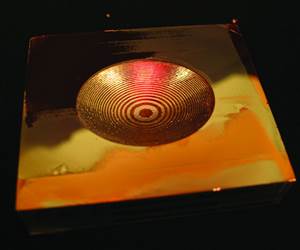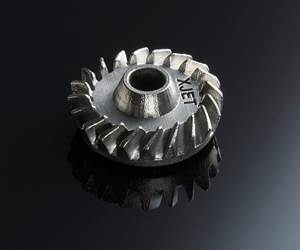AMGTA Releases Preliminary Research Results on Sustainability of Powder and Wire Additive Manufacturing Feedstock
The study evaluated three key metal AM feedstock processing approaches — gas atomization, mechanical milling (specifically ball milling) and wire drawing — to determine specific energy requirements for producing feedstock materials.
The Additive Manufacturer Green Trade Association (AMGTA), a global advocacy group focused on promoting sustainable additive manufacturing (AM) industry practices, has released the preliminary results of a research project titled, “Specific Energy of Metal AM Feedstock: A Comparison.”
The study was commissioned by the AMGTA and conducted by Syntec Associates (a research consultancy) in partnership with Divergent Technologies (a complete modular digital factory for complex structures). It evaluated three key metal AM feedstock processing approaches — gas atomization, mechanical milling (specifically ball milling) and wire drawing — to determine specific energy requirements for producing feedstock materials.
The research findings highlighted that, from an energy perspective, helium gas atomization is the most sustainable method used for gas atomization for metallic powder production of commonly used alloys, followed by argon and then nitrogen. Specific energy consumption for atomization also critically depends on process parameters and alloy chemistry. Additionally, research showed that mechanical milling, when appropriate for use in powder production in AM, exhibits a significant reduction in specific energy consumption when compared to gas atomization.
“When preparing life cycle assessments on industrial rate processing of our alloys, I found wide variation in the literature on AM process and powder atomization energy consumption,” says Michael Kenworthy, chief technology officer at Divergent Technologies and AMGTA board director. “This research established a transparent set of process assumptions and models from which to understand the key process levers and evaluate system trade studies that inform future sustainability enhancements.”
Key takeaways from this study include:
- Helium gas atomization is the best for powder atomization: Research indicates that, from an energy perspective, helium gas atomization stands out as the most sustainable gas atomization method, showing a significant reduction in specific energy consumption compared to argon and nitrogen for commonly used alloys.
- Argon atomized powder is better than nitrogen: For those seeking an alternative to helium, argon-atomized powder is revealed to be a notable option for energy savings when compared to nitrogen-atomized powder.
- Mechanical milling outperforms gas atomization: Mechanical milling, particularly ball milling, demonstrates a significant reduction in specific energy consumption compared to gas atomization for metal AM powder production.
- Industry guidance for sustainable choices: This research highlights the importance of selecting manufacturing methods with the lowest specific energy consumption per kilogram to enhance overall sustainability when producing feedstock materials used in AM.
“A primary goal of the AMGTA is to educate the consumer on the most sustainable methods of production within the additive supply chain. This important piece of research provides guidance on which methods of gas atomization require the least amount of specific energy per kilogram,” says Brian R. Neff, AMGTA’s board chair. “At the same time, it indicates to the market that mechanical production methods of powder feedstock, such as ball milling, are themselves an order of magnitude better than gas atomization from an energy perspective.”
Gas atomization, deemed a promising technology for producing stock powders for AM, was a focal point of the study. The research revealed that gas atomization using helium as the atomization gas resulted in the least total specific energy consumption compared to argon (13% better on average) and nitrogen (28% better on average). Additionally, argon-atomized powder was found to reduce energy requirements by 12% when compared to nitrogen-atomized powder for the alloys studied (SS316L, Al5083, and IN718).
The study also highlights the efficiency of mechanical powder production, particularly ball milling, which showed approximately a 90% improvement in specific energy consumption compared to gas atomization for the range of process conditions studied. Further research is recommended to determine the applied impact within specific product categories of using helium-atomized powder and/or ball milled powder.
“This research aligns with the AMGTA commitment to better understand sustainable manufacturing practices leveraging additive technologies,” says Sherri Monroe, the AMGTA’s executive director. “These findings highlight key considerations for manufacturers seeking environmentally friendly feedstock production methods. To advance sustainability in additive manufacturing, research is vital in order to make informed decisions.”
Highlights from the study can be found on the AMGTA’s website. The AMGTA says it expects to publish additional independent research throughout 2024. Additional information on this study and others conducted by the AMGTA can also be found on the AMGTA website, www.AMGTA.org.
The AMGTA was launched in 2019 to better understand and promote the environmental benefits of AM across the global economy. AMGTA members represent the entirety of the manufacturing spectrum — from design and raw materials to end products and users — focused on innovating better, more sustainable and financially advantageous products through best additive practices.
Related Content
Aluminum Gets Its Own Additive Manufacturing Process
Alloy Enterprises’ selective diffusion bonding process is specifically designed for high throughput production of aluminum parts, enabling additive manufacturing to compete with casting.
Read MoreAM 101: What is Ultrasonic Additive Manufacturing?
Going from additive to subtractive can be simple with Ultrasonic Additive Manufacturing (UAM). What is it and how does it work? Learn the basics in this 101 post.
Read MoreWorld’s Largest Metal 3D Printer Seen at Ingersoll Grand Opening Event
Maker of large additive and subtractive machines adds capacity in Rockford, Illinois.
Read MoreAM 101: NanoParticle Jetting (NPJ)
The proprietary process from XJet builds ceramic and metal parts using nanoparticle suspensions. Learn how NPJ works in this introductory article, part of our AM 101 series.
Read MoreRead Next
3D Printing Brings Sustainability, Accessibility to Glass Manufacturing
Australian startup Maple Glass Printing has developed a process for extruding glass into artwork, lab implements and architectural elements. Along the way, the company has also found more efficient ways of recycling this material.
Read MoreVideo: Intelligent Layering Metal 3D Printing at 3DEO
Contract manufacturer 3DEO delivers metal parts using Intelligent Layering, a binder jetting-like 3D printing process the company developed and operates internally. Here’s how it works.
Read MoreTo Improve Performance of Compression Molded Composites, Add 3D Printed Preforms
9T Labs' Additive Fusion Technology enables the manufacture of composite structures with as much or as little reinforcement as is necessary, using 3D printed continuous fiber preforms to add strength just where needed.
Read More








.png;maxWidth=300;quality=90)















